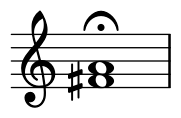Dial tone and busy signal
Henry Lowengard left a comment on my post Phone tones in musical notation mentioning dial tones and busy signals, so I looked these up.
TonesAccording to this page, a dial tone in DTMF [1] is a chord of two sine waves at 350 Hz and 440 Hz. In musical notation:

According to the same page, a busy signal is a combination of 480 Hz and 620 Hz with pulses of 1/2 second.

Note that the bottom note is an B half flat, i.e. midway between a B and a B flat, denoted by the backward flat sign. The previous post on DTMF tones also used quarter tone notation because the frequencies don't align well with a conventional chromatic scale. The frequencies were chosen to be easy to demodulate rather than to be musically in tune.
Audio filesHere are audio files corresponding to the notation above.
dial tone
https://www.johndcook.com/dial2.wav
busy signal.
https://www.johndcook.com/busy2.wav
Here is the Lilypond code that was used to make the images above.
\begin{lilypond} \new Staff \with { \omit TimeSignature} { \relative c'{ 1 \fermata | } } \new Staff { \tempo 4 = 120 \relative c''{ <beh dis> r4 <beh dis> r4 | <beh dis> r4 <beh dis> r4 | } } \end{lilypond}Related posts[1] Dual-tone multi-frequency signaling, trademarked as Touch-Tone
The post Dial tone and busy signal first appeared on John D. Cook.